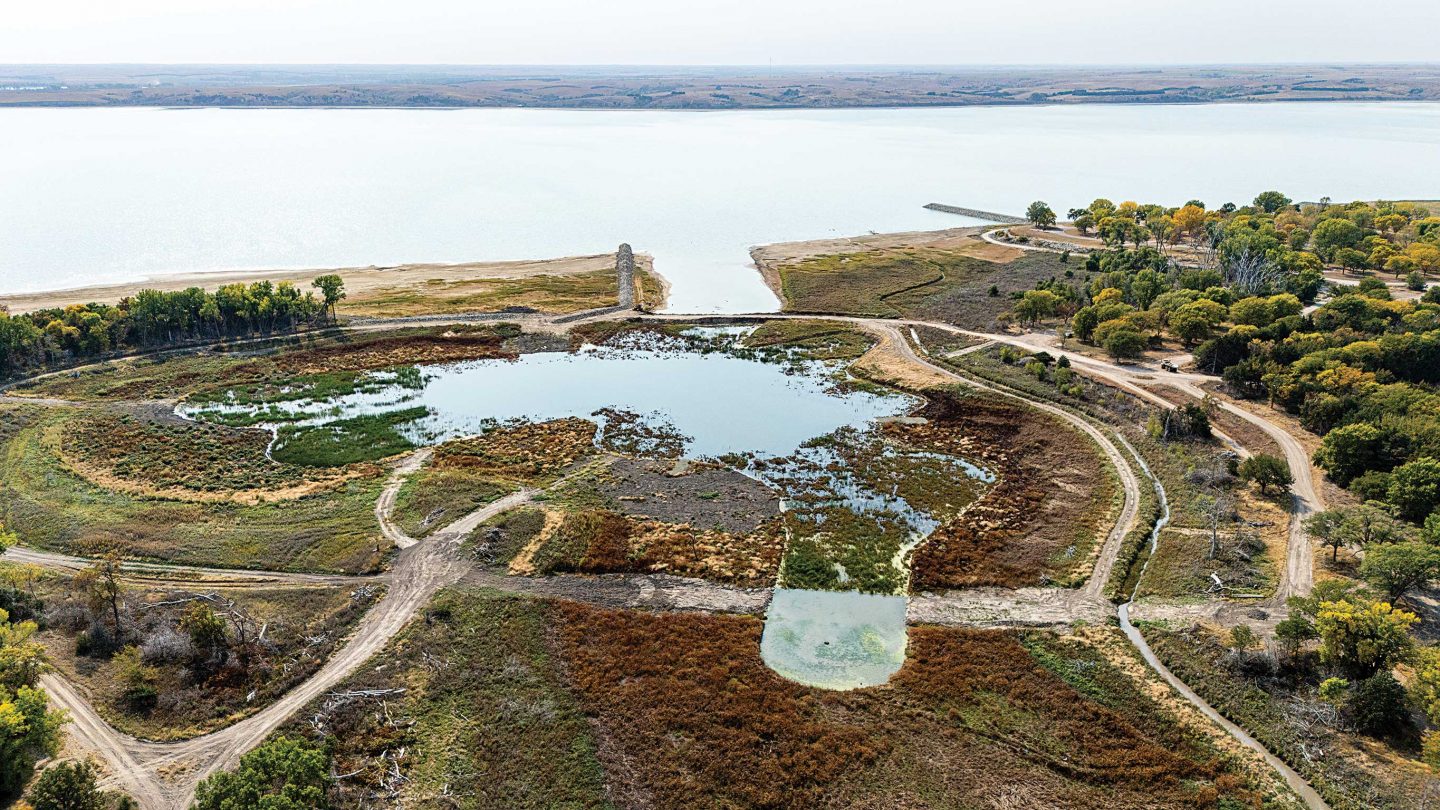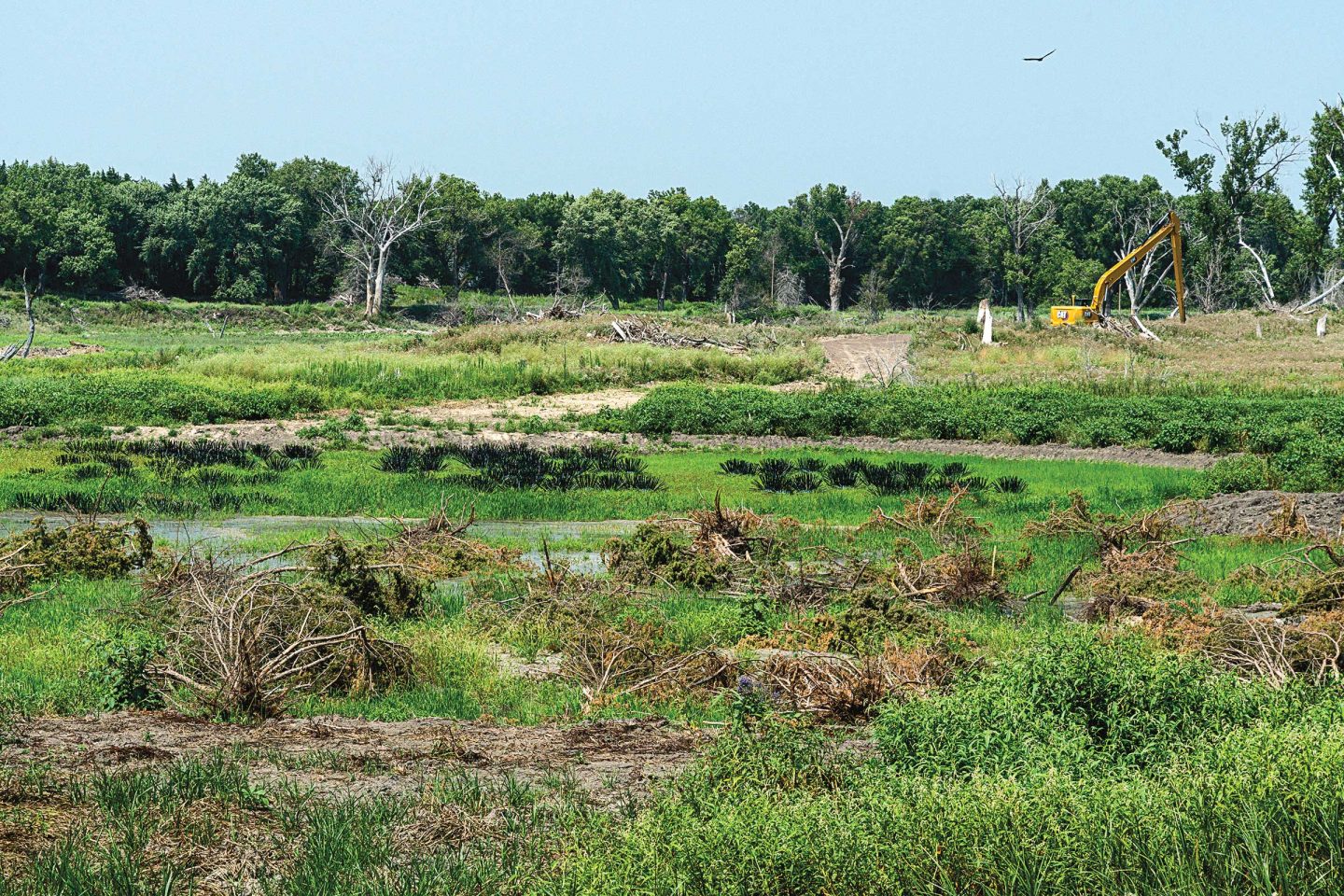
By Eric Fowler
When reservoirs are new, and creekbottoms and draws that once led to the river that was dammed fill with water, they can be incredible fisheries. As the reservoirs age and shorelines erode, however, the mouths of those bays can become filled with sediment, disconnecting them from the lake. That was the case with Methodist Cove on the north side of Harlan County Lake.
Thanks to a $9.25-million aquatic ecosystem restoration project set to be completed this spring that removed 150,000 cubic yards of silt and dredged a channel between the cove and the lake, connection between the two will be more frequent. The result should provide a spark to the lake’s fish populations, especially crappie, and provide more opportunities for anglers.
At Harlan County Lake, ice heaves and wind-driven waves had no trouble moving light, eroded soils up and down the bank. That lateral movement of sediment had formed berms across the mouths of all but two of 29 coves, Patterson Harbor and Gremlin Cove, both at the east end of the reservoir near the dam, separating them from the reservoir except when it was at or near full pool.
Prior to the habitat project, Methodist Cove became disconnected from the reservoir when water levels dropped less than 4 feet, and 11 times since 2000, the lake did not rise enough in the spring to spill into the bay. When it did and fish were able to spawn there, falling water levels when the irrigation season began often trapped and doomed their young.
Now, a 200-foot-wide channel connects the cove and the lake when the lake is 9 feet from full pool. It was designed to facilitate access to and from the cove in most years with two critical time periods for crappies in mind: mid-April to mid-May, when adults are looking for spawning habitat; and early July, when young of the year are large enough to head for the reservoir.
Additionally, the bay was less than 6 feet deep. After 100,000 cubic yards of sediment was removed — enough to cover a football field 50 feet deep — water will be up to 17 feet deep when the lake is full, much closer to the depth found there when the lake first filled in 1957. Even when it becomes disconnected, water will be 8 feet deep, enough for fish to survive the winter. More than 150 artificial structures and roughly 1,000 dead cedar trees, as well as a 300-foot-long rock shoal, were placed in the bay to provide spawning habitat and cover for fish.
Water levels in the lake, dependent on precipitation in the Republican River Basin that doesn’t always replenish water released for irrigation, have varied widely through the years. “There are going to be times that [Methodist Cove] doesn’t connect, but you’re going to just have it function so many more years than if we wouldn’t have done anything like this,” said Tom Zikmund, who manages the lake for the U.S. Army Corps of Engineers.
On both sides of the cove, shorelines were protected with riprap and jetties were built to prevent sediment from filling the new channel. The 500-foot jetty on the west side of the cove extends from one of the Corps’ two major campgrounds on the lake and will provide anglers access to deeper water.
A half-mile north of the lake, Corps Road B dissects the creekbottom, forming a pond that had filled with silt washed in from pastures and fields in the watershed and was just a foot deep. The project removed 52,000 cubic yards of sediment from the pond. Now 5 feet deep and bisected with fingers, it will continue to capture sediment. Fed by reliable flows from spring-fed Methodist Creek, it will also provide additional shore fishing opportunities, as well as habitat for waterfowl and other wildlife. Game and Parks plans to stock largemouth bass, bluegills and crappies there this spring.

Federal funding from a program designed to improve aquatic habitat on aging Corps reservoirs covered 75 percent of the cost. The Nebraska Game and Parks Commission’s Aquatic Habitat Program funded the other 25 percent. Project managers with the Corps and Game and Parks fisheries biologists began looking at ways to reconnect coves to the reservoir about 15 years ago.
Keith Koupal, a reservoir specialist with Game and Parks, said state and federal biologists weighed the cost and benefits of reconnecting six coves on the lake. For each, they looked at how deep the coves were, how much excavation would need to be done to reconnect them to the reservoir, how many years they would remain connected under typical lake levels and how many acres of habitat would be available to fish. While reconnecting other bays may have taken less work at less cost, the size of Methodist Cove, and its location on the upper end of the reservoir, where it was more affected by seasonal drawdowns, made it the best choice. “We’re kind of making a small lake within a big reservoir,” Koupal said.
Zikmund said his sons are among the many kids who ride bicycles to the Methodist Cove to fish. He expects the project will draw more anglers, both young and old, and they are working on plans to improve access around the bay. “I’m very excited about having more opportunities for people to bank fish,” he said.
The Aquatic Habitat Program had previously funded a project to protect Patterson Cove. Both agencies hope they can work to reconnect more of the coves on the lake. That will make crappie anglers, especially the ones who remember fishing in Methodist Cove when the lake was new, happy. “In all of my years of being around the lake, any time the water is high, everybody is excited about the crappie,” Zikmund said. “They all kind of know that we’re going to have coves that have crappie in them.”
